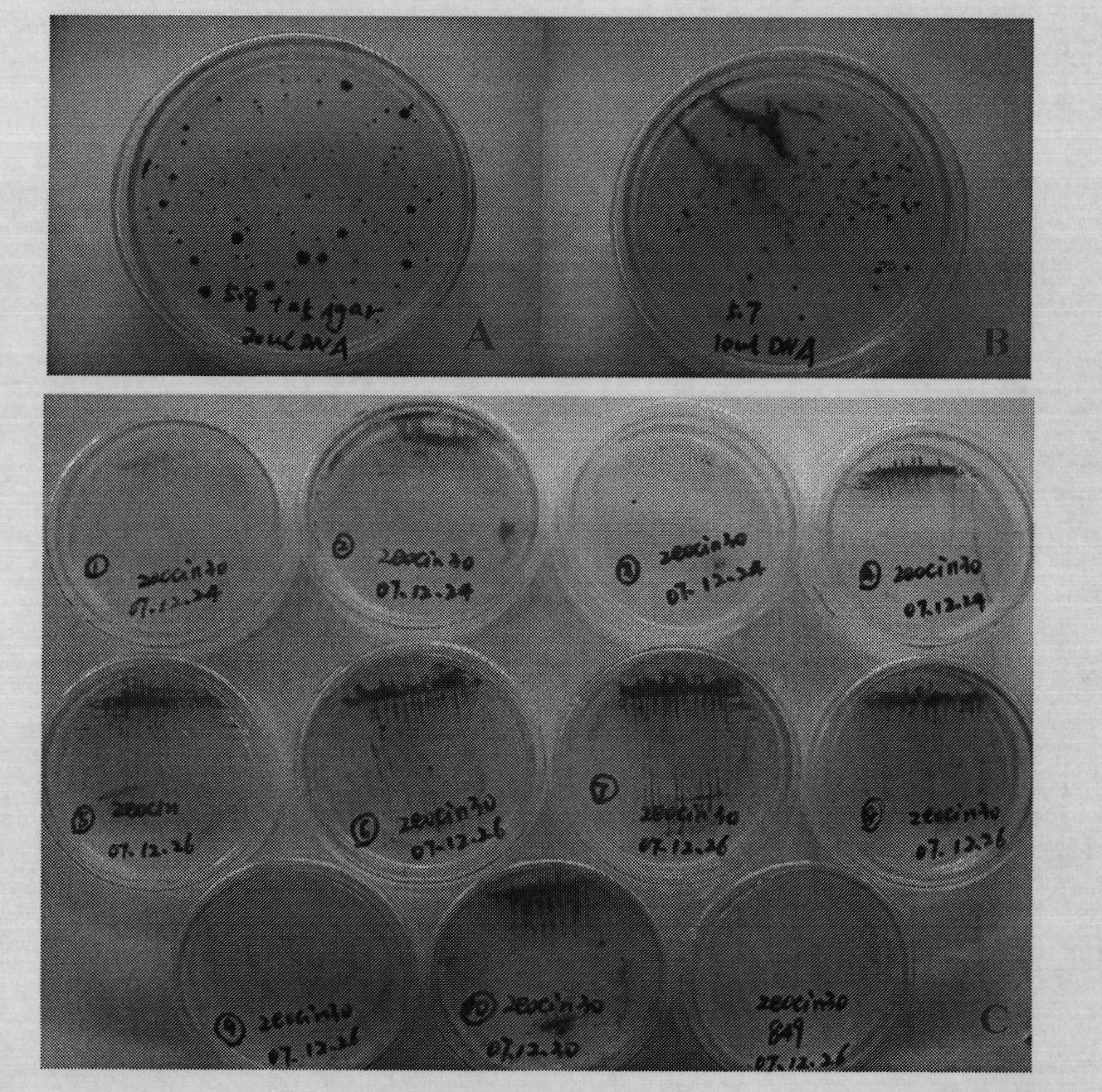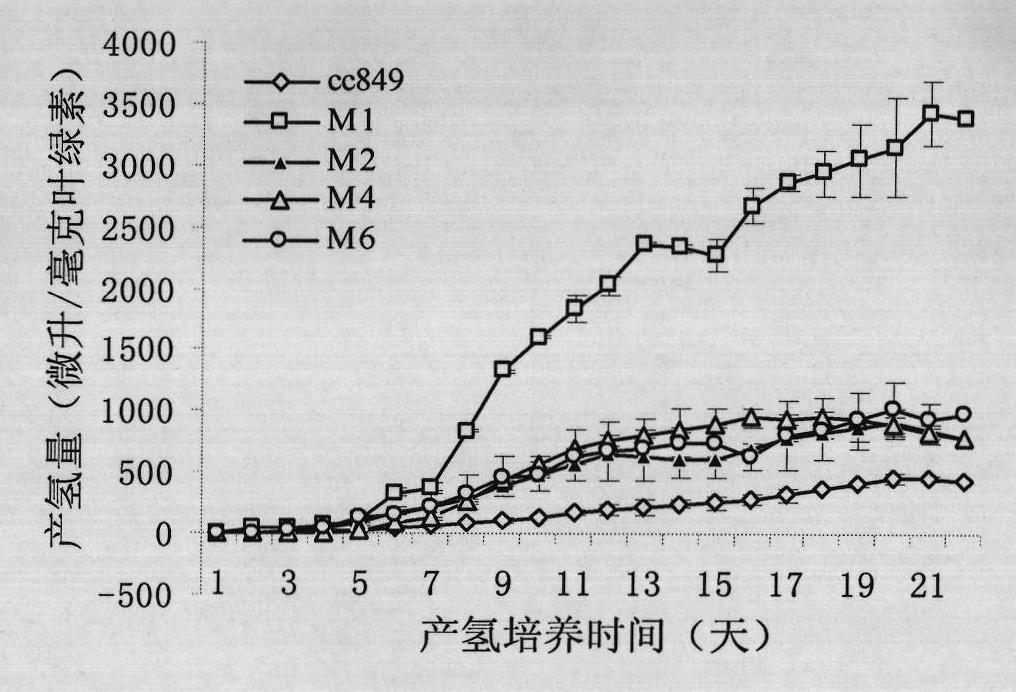Method for breeding high-yield photosynthetic-hydrogen-production chlamydomonas reinhardtii through cell nucleus insertion mutagenesis
A technology of hydrogen rheindulae and rheindala, which is applied in the field of nuclei insertion mutagenesis and breeding of high-yield photosynthetic hydrogen-producing Chlamydomonas reinhardtii, which can solve the problems that cannot solve the problem of the hydrogen production rate of Chlamydomonas reinhardtii and limit the application and development of biological photosynthetic hydrogen production technology. And other issues
- Summary
- Abstract
- Description
- Claims
- Application Information
AI Technical Summary
Problems solved by technology
Method used
Image
Examples
Embodiment 1
[0080] Cultivation of Chlamydomonas reinhardtii:
[0081] Chlamydomonas reinhardtii has fast growth rate, low culture cost and high hydrogenase activity, so it is a representative species of microalgae for photosynthetic hydrogen production. In order to facilitate transgene manipulation, the present invention prefers Chlamydomonas reinhardtii species cc849 with a cell wall deficiency.
[0082] ①Normal culture conditions of Chlamydomonas reinhardtii: According to "The Chlamydomonas Sourcebook: a comprehensive guide to biology and laboratory use. New York: Academic Press. 1989" edited by Harris, preferably at 25±1°C, sunlight intensity (100-200 μmol photons m -2 the s -1 ), liquid culture is in 50~100ml Tris-Acetate-Phosphate (TAP) culture medium, initial pH7.2, horizontal shaker speed 100~130rpm, every 5~6 days 1% inoculation subculture; Solid TAP plate culture medium Containing 1.5% agar powder, the preservation and purification of the algal species is to pick a single clone...
Embodiment 2
[0086] Preparation of Chlamydomonas reinhardtii nuclear transformation vector and preparation of glass beads:
[0087] 1. Extraction and purification of plasmid pSP124S: described by standard methods known to those skilled in the art (Sambrook et al., Molecular Cloning. New York: Cold Spring Harbor Laboratory Press. 1998) and Lumbreras et al. Methods (The Plant Journal, 1998, 14:441-448) and TIANGEN plasmid extraction kit (TIANprep Mini kit) were used to extract and purify the vector pSP124S. Specifically, take 1-5 mL of overnight cultured E. coli liquid containing the pSP124S plasmid, centrifuge at 12,000 rpm for 1 min at 4°C to collect bacterial cells, add 250 μl of P1 (with RNase A added in advance) and 250 μl of P2, and gently flip up and down for 6- 8 to fully lyse the cells; then add 350 μl of P3, immediately turn it gently up and down for 6-8 times to fully mix the cells, centrifuge at 12,000 rpm for 10 min at 4°C, transfer the supernatant to the adsorption column CB3, ...
Embodiment 3
[0093] Nuclear transformation of Chlamydomonas reinhardtii and screening of transformants:
[0094] ① Transformation of the nucleus of Chlamydomonas reinhardtii:
[0095] Transform the nucleus of Chlamydomonas reinhardtii by the glass bead transformation method of Kindle (Proc.Natl Acad.Sci.US A.1990, 87:1228 1232), take 100ml and grow to the middle and late logarithmic phase (about 4~5×10 6 ), Chlamydomonas reinhardtii with healthy and active cells, collected algal cells by centrifugation at 4000rpm for 5min at 25°C, washed three times with fresh TAP, and resuspended the algal cells with fresh TAP to make the cell concentration 2×10 8 cells / ml. Pipette 300μl of Chlamydomonas suspension into a 15ml test tube, which contains 0.3g of sterilized glass beads, and add 5μg of the purified DNA of the linearized plasmid pSP124S into the test tube, and the mixture is shaken at the maximum on the WH-816 vortex shaker Intensity, 45-degree oblique vortex oscillation for 15-30 seconds. ...
PUM
 Login to View More
Login to View More Abstract
Description
Claims
Application Information
 Login to View More
Login to View More - R&D
- Intellectual Property
- Life Sciences
- Materials
- Tech Scout
- Unparalleled Data Quality
- Higher Quality Content
- 60% Fewer Hallucinations
Browse by: Latest US Patents, China's latest patents, Technical Efficacy Thesaurus, Application Domain, Technology Topic, Popular Technical Reports.
© 2025 PatSnap. All rights reserved.Legal|Privacy policy|Modern Slavery Act Transparency Statement|Sitemap|About US| Contact US: help@patsnap.com



